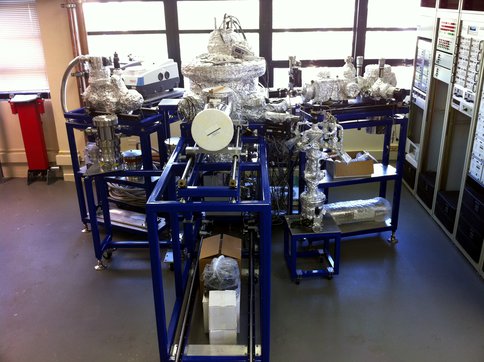2010 Annual Science Report
 University of Hawaii, Manoa
Reporting | SEP 2009 – AUG 2010
University of Hawaii, Manoa
Reporting | SEP 2009 – AUG 2010
Keck Astrochemistry Laboratory
Project Summary
A new Keck Astrochemistry laboratory is being set up in which low temperature, high vacuum ice irradiation experiments can take place to simulate molecule formation in space. This will be used to explore the formation of molecules of astrobiological relevance and understand the changes that occur in the space environment. The lab will be unique because it is the only one with multiple sources of radiation over the whole spectrum and will have multiple analytical tools to measure the products so that the data can be compared to astronomical observations.
Project Progress
Postdoc Chris Bennett and Brandt Jones have been helping to set-up the Keck Astrochemistry Laboratory. The laboratory will be unique in that it will be the only one with multiple sources of irradiation covering the spectrum of the Galactic ray background and having multiple analytical tools that can be compared directly with telescope and ground based observations. Bennett he has been an essential part of throughout the design, acquisition of parts, and construction phases. However, due to the fact that extensive renovations have been underway for the majority of this time, the amount of experimental time working on this project has been minimal, and it was only possible carry out preliminary testing of several of the components which will eventually be implemented into the Keck Machine. Chris has worked hard on successfully implementing an ion source into our experimental apparatus on a separate chamber which has extended our capabilities to additionally investigate the effects of low energy ions which are application to a number of astronomical environments. This work involved extensive trouble-shooting due to some defects with the experimental apparatus, but he managed to work with the manufacturer to pin-point and solve these problems. Here, he worked with Dr. Courtney Ennis on some preliminary focusing on the formation of Ozone (O3) when molecular oxygen ice (O2) is irradiated by particles, and the formation of d2-water (D2O) and d2-carbonic acid (D2CO3) when D2+ ions were implanted into molecular oxygen and carbon dioxide (CO2) ices, respectively. As a result, two papers have been produced; one is currently one paper is under review, the other is still in preparation. He has also been involved in preliminary works testing several other components that will be implemented into the Keck instrument; namely the UV-VIS spectrometer, FTIR spectrometer, and a Kelvin Probe.
Brandt was responsible for the design of a pulsed vacuum ultraviolet (VUV) light source for the purpose of selective ionization and one continuous VUV/UV light source for photon irradiation purposes. Selective ionization process will allow for the deduction of particular isomers that may be formed during the irradiation process (electrons, positive ions, and photons); an ability that standard mass spectrometry lacks. This pulsed VUV light source is currently being assemble and will be operational by the end of the year. The irradiation light source is unique in that it can be operated in full band mode, similar to that of a star, or narrow band width mode allowing us to select a specific wavelength e.g., Lyman-alpha line, for irradiation experiments. This will help elucidate what the exact conditions are necessary in order for astrobiologically important molecules to form in Kuiper belt objects. This light source has been assembled and tested successfully. In addition, a “solar blind” detector has been successfully implemented further enhancing the capabilities of the light source. This detector will now allow the device to be used as an analytical tool (operating in low flux, high resolution) producing an absorption spectrum of the irradiated ices.
Portion of the new Keck Astrochemistry laboratory being developed.
Publications
-
Ennis, C. P., Bennett, C. J., & Kaiser, R. I. (2011). On the formation of ozone in oxygen-rich solar system ices via ionizing radiation. Physical Chemistry Chemical Physics, 13(20), 9469. doi:10.1039/c1cp20434c
-
Ennis, C., Bennett, C. J., Jones, B. M., & Kaiser, R. I. (2011). FORMATION OF D 2 -WATER AND D 2 -CARBONIC ACID IN OXYGEN-RICH SOLAR SYSTEM ICES VIA D + 2 IRRADIATION. The Astrophysical Journal, 733(2), 79. doi:10.1088/0004-637x/733/2/79
-
PROJECT INVESTIGATORS:
-
PROJECT MEMBERS:
Ralf Kaiser
Project Investigator
Chris Bennett
Co-Investigator
Brant Jones
Co-Investigator
-
RELATED OBJECTIVES:
Objective 2.2
Outer Solar System exploration
Objective 3.1
Sources of prebiotic materials and catalysts
